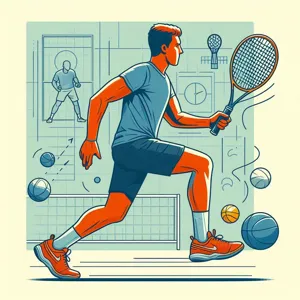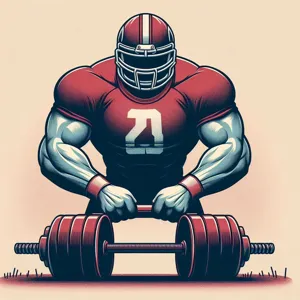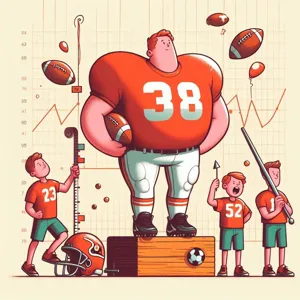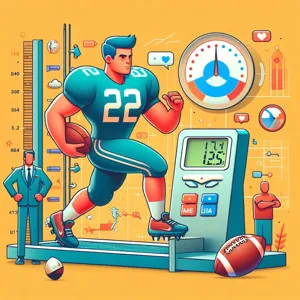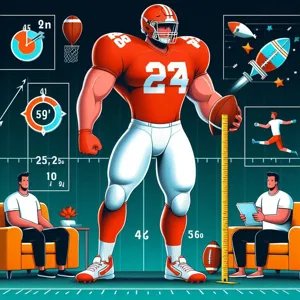In the fast-paced world of tennis, the ability to move swiftly and efficiently around the court can make all the difference between victory and defeat.
Whether you’re a seasoned player looking to refine your skills or a novice eager to elevate your game, foot speed is a crucial component that often determines your performance. Imagine chasing down every shot with agility, executing quick lateral movements, and positioning yourself perfectly to deliver that winning serve. In this blog post, we’ll explore a series of proven drills designed to enhance your foot speed, helping you become quicker on your feet and more competitive in matches. From agility ladder exercises to cone drills, these techniques are not only effective but also fun, ensuring that you’ll look forward to incorporating them into your training regimen. Get ready to unlock your potential and take your tennis game to the next level!
1. Introduction to Tennis Foot Speed

Tennis is a game of quick reactions, agile movements, and explosive bursts of energy, all of which hinge on one crucial element: foot speed. The ability to move swiftly around the court, change directions with precision, and position yourself optimally for each shot can significantly influence your performance and overall game strategy. Unlike many sports, where linear sprints dominate, tennis demands a unique combination of lateral agility, acceleration, and deceleration.
At its core, tennis foot speed is not merely about how fast you can run; it’s about how effectively you can respond to your opponent’s shots, anticipate the ball‘s trajectory, and maintain balance while executing your strokes. The faster you can get to the ball, the more time you have to prepare your shot, which often translates into a higher success rate on the court.
Improving your foot speed involves more than just endurance training; it requires specialized drills that enhance your agility, coordination, and explosiveness. Whether you’re a beginner aiming to improve your game or an advanced player looking to sharpen your skills, focusing on foot speed will elevate your overall tennis performance. In this section, we’ll explore the fundamentals of tennis foot speed and lay the groundwork for the drills that will help you become quicker on your feet, allowing you to dominate the court with confidence and finesse.
2. The Importance of Foot Speed in Tennis
Foot speed is a crucial element in the sport of tennis, serving as the foundation for nearly every aspect of gameplay. Unlike many sports that may prioritize strength or endurance, tennis demands a unique combination of agility, quickness, and precision. When you’re on the court, your ability to move swiftly from one side to the other, to approach the net, or to reposition after a powerful serve can make the difference between winning and losing a point.
The dynamic nature of tennis requires players to react to a constantly changing environment. Whether it’s a powerful forehand coming your way or a soft drop shot that demands a sudden burst of speed, your footwork dictates your positioning and readiness. Players with superior foot speed can cover the court more efficiently, allowing them to reach balls earlier and set up for optimal shot execution. This not only enhances your ability to return shots but also provides a psychological edge over your opponent, as they may perceive you as a more formidable competitor.
Moreover, improved foot speed contributes to better balance and stability. When your feet are agile, you can adjust your stance more effectively, enabling you to maintain control during rapid exchanges. This control helps reduce the risk of injury, as your body is better equipped to handle the demands of sudden movements.
In essence, developing foot speed is not just about moving quickly; it’s about enhancing overall performance on the court. By focusing on drills that boost your foot speed, you’re investing in your ability to play at a higher level, covering the court with confidence and grace. In the following sections, we will explore specific drills that can help you achieve this goal, transforming your footwork into one of your greatest assets in your tennis arsenal.
3. Assessing Your Current Foot Speed

Before you can embark on a journey to enhance your foot speed on the tennis court, it’s crucial to first assess where you stand. Understanding your current foot speed will not only provide a baseline for your progress but also help you identify specific areas that need improvement.
Begin by conducting a simple yet effective series of tests. Set up a 10-meter distance on a flat surface, and with a stopwatch in hand, time how long it takes you to sprint from one end to the other. Repeat this drill three times, recording your best time to ensure accuracy. This sprint test will give you a clear indication of your current speed and explosiveness.
Next, incorporate lateral movement into your assessment. Tennis requires quick side-to-side movements, so a lateral shuffle drill is essential. Mark two points five meters apart and time how long it takes to shuffle back and forth between them for 30 seconds. This drill will help you gauge your agility and ability to change direction quickly, both crucial aspects of foot speed in tennis.
Additionally, consider evaluating your reaction time, as it plays a significant role in how quickly you can move in response to your opponent’s shots. You can do this by having a partner throw tennis balls at varying angles, measuring how long it takes you to reach and return each shot.
Once you have gathered these metrics, you’ll have a clearer picture of your current foot speed and the areas that need the most attention. This baseline assessment will serve as a valuable reference point as you implement the drills and training techniques in the following sections, ultimately helping you to refine your footwork and elevate your game on the court. Remember, the journey to becoming quicker on your feet starts with honest self-evaluation.
4. Dynamic Warm-Up Exercises
Dynamic warm-up exercises are essential for preparing your body for the fast-paced movements required in tennis. Unlike static stretches, which can leave your muscles feeling tight and unresponsive, dynamic warm-ups actively engage your muscles and improve your range of motion while elevating your heart rate. This not only enhances your overall performance but also reduces the risk of injury.
Start with a series of leg swings, where you stand next to a wall or support and swing one leg forward and backward, gradually increasing the range as you loosen up. This movement targets your hip flexors and hamstrings, crucial for explosive footwork on the court. Follow this with high knees and butt kicks—two exercises that engage your core while also emphasizing the quick lifting and planting of your feet, mimicking the movements you’ll make during a match.
Incorporate lateral lunges and carioca drills to activate your side-to-side movement. These exercises help to develop agility and quick lateral response, ensuring that you can dart across the court to return those tricky shots. As you perform each drill, focus on maintaining an athletic stance: knees slightly bent, weight balanced on the balls of your feet, ready to spring into action.
Finally, add some skips and quick sprints to your warm-up routine. These drills not only stimulate your cardiovascular system but also reinforce the muscle memory necessary for quick starts and stops. By dedicating time to these dynamic warm-up exercises, you’ll not only boost your foot speed but also enhance your overall agility on the court, allowing you to react faster and play more confidently in your matches.
5. Ladder Drills for Agility

Ladder drills are a staple in the training routines of many athletes, and for good reason—they are incredibly effective at enhancing agility and foot speed, which are crucial for success on the tennis court. These drills involve a simple agility ladder, which can be laid flat on any surface, making it easy to incorporate into your practice sessions, whether at home, on the court, or at the gym.
To get started, position the ladder on the ground and begin with the most basic drill: the two-foot hop. Stand at the beginning of the ladder and hop into the first square with both feet landing simultaneously. Move quickly through the rungs, focusing on keeping your knees high and landing softly to maintain balance. As you progress, try variations like the lateral shuffle, where you move sideways through the ladder, or the in-and-out drill, where you alternate stepping in and out of the squares.
These drills not only improve your footwork but also enhance your coordination and overall body awareness. As you weave through the ladder, concentrate on your rhythm and speed—your goal is to complete the sequence as quickly as possible without tripping over the rungs. To maximize the benefits, incorporate these drills into your regular training routine, aiming for at least three sessions per week. Over time, you’ll notice a significant improvement in your ability to change direction quickly and react to your opponent’s movements on the court.
Ladder drills also provide a dynamic warm-up option, getting your heart rate up while engaging the muscles you rely on during a match. By adding this simple yet effective tool to your training arsenal, you’ll not only boost your foot speed but also gain a competitive edge in your game. So grab a ladder, lace up your shoes, and get ready to elevate your agility to new heights!
6. Cone Drills for Directional Speed
Cone drills are a fantastic way to enhance your directional speed on the court, allowing you to move swiftly and efficiently in response to your opponent’s shots. These drills not only improve your footwork but also develop your agility, coordination, and overall court awareness. The beauty of cone drills lies in their versatility; you can customize the layout and intensity to fit your skill level and training goals.
To get started, set up a series of cones in various configurations on the court. A common setup is to place five cones in a star shape, with one cone in the center and the others spaced evenly around it. This formation allows you to practice moving in different directions—forward, backward, and laterally—while maintaining your balance and focus on foot placement.
One effective exercise is the “Cone Sprint.” Begin at the center cone and sprint to the first cone, touch it, and then quickly pivot to the next cone. Repeat this pattern, emphasizing quick, explosive movements and sharp turns. This drill mimics the rapid changes in direction you’ll encounter during a match, helping you develop muscle memory and increase your reaction time.
Another great variant is the “Zig-Zag Drill.” Arrange your cones in a zig-zag pattern and practice sprinting from one cone to the next, focusing on quick, light steps as you change directions. This drill is particularly beneficial for improving your lateral movement, which is crucial for reaching those tricky shots near the sidelines.
As you become more comfortable with the drills, you can increase the intensity by incorporating a tennis ball, either by tossing it in the air to catch as you move between cones or having a partner hit balls to you while you navigate the layout. This added challenge will simulate the unpredictability of a real match and sharpen your foot speed even further.
Incorporating cone drills into your regular training routine will not only boost your foot speed but also instill a greater sense of control over your body movements on the court. With consistent practice, you’ll find yourself darting to the ball with newfound agility, giving you a significant advantage in your game.
7. Shadow Tennis: Practicing Movement without the Ball

Shadow tennis is a unique and highly effective drill that allows players to focus on their footwork and court movement without the distraction of a ball. This technique encourages you to visualize the game, honing your agility and speed as you move around the court.
To begin, find a spacious area, preferably on a court, where you can move freely. Start by imagining a rally, picturing an opponent hitting the ball to various parts of the court. As you engage in this exercise, simulate the footwork required for each shot—whether it’s a forehand, backhand, or volley. Concentrate on your foot positioning, balance, and the quickness of your movements.
As you practice, pay attention to your body mechanics; ensure that your knees are slightly bent, your feet are light on the ground, and your movements are explosive yet controlled. You can incorporate different patterns to mimic match scenarios: sprint to the net for a volley, drop back for a deep return, or slide sideways to reach a wide shot.
For added intensity, set a timer and challenge yourself to maintain a high level of energy. This can be a great way to work on your endurance as well. Shadow tennis not only builds your foot speed but also enhances your court awareness and reaction time, enabling you to be more agile and responsive during actual matches. Plus, it’s a fantastic way to practice your technique and refine your strokes without needing a partner or a ball.
By dedicating time to shadow tennis in your training routine, you’ll develop the quickness and agility necessary to outmaneuver your opponents on the court, giving you a competitive edge when it counts.
8. Plyometric Exercises to Enhance Explosiveness
Plyometric exercises are a game-changer when it comes to enhancing explosiveness on the tennis court. These high-intensity movements focus on the rapid stretching and contracting of muscles, allowing players to develop the power and speed crucial for sprinting to the net or chasing down a deep baseline shot. Incorporating plyometric exercises into your training regimen can significantly improve your foot speed and overall agility.
One effective plyometric drill is the **Box Jump**. Find a sturdy platform or a plyometric box and stand in front of it with your feet shoulder-width apart. Bend your knees slightly, then explode upward, landing softly on the box with your knees slightly bent to absorb the impact. This drill not only builds leg strength but also trains your body to generate quick bursts of power, mimicking the explosive movements needed in tennis.
Another excellent exercise is the **Lateral Bounds**. Begin by standing on one leg, then push off laterally, landing on the opposite leg. Focus on maintaining balance and control as you leap side-to-side, which replicates the lateral movements required during a match. To increase difficulty, you can add a jump at the peak of each bound, enhancing your explosiveness further.
Finally, don’t overlook the **Depth Jump**. This drill involves stepping off a box and immediately jumping as high as possible upon landing. The key is to minimize ground contact time, training your muscles to react quickly and efficiently—perfect for those split-second decisions on the court.
Incorporating these plyometric exercises into your training not only boosts your foot speed but also enhances your overall athletic performance, making you a more formidable opponent on the tennis court. Remember to warm up properly and focus on form to maximize benefits and reduce the risk of injury. With consistent practice, you’ll notice a significant improvement in your explosiveness, giving you the edge you need during high-stakes matches.
9. Resistance Training for Improved Strength
When it comes to boosting your foot speed on the tennis court, resistance training is a game-changer. Unlike typical cardio exercises, resistance training focuses on building the strength of your muscles, allowing you to move quicker and more explosively. This type of training engages not only your legs but also your core, which plays a crucial role in your overall agility and stability during matches.
Incorporate exercises like squats, lunges, and deadlifts into your routine. These foundational movements target the major muscle groups in your lower body, enhancing your power and endurance. To add an extra challenge, consider using resistance bands or weighted vests. These tools create additional tension, forcing your muscles to work harder, which translates into greater strength and speed on the court.
Another effective method is plyometric training, which involves explosive movements such as box jumps and lateral hops. These drills develop fast-twitch muscle fibers, essential for quick sprints and sharp changes in direction—the very movements that can make or break a point in tennis.
Don’t forget to focus on your upper body as well. Strong shoulders and arms contribute to your overall balance and stability, allowing for quicker recovery between shots. Incorporate exercises like push-ups and shoulder presses to ensure your entire body is conditioned for peak performance.
By committing to a structured resistance training program, you’ll not only see improvements in your foot speed but also in your overall game. The combination of strength and agility will give you the competitive edge needed to outmaneuver your opponents and dominate the court.
10. Incorporating Interval Sprints into Your Routine
Incorporating interval sprints into your training routine is a game-changing strategy for enhancing your tennis foot speed. The essence of interval sprints lies in their ability to mimic the explosive bursts of energy required during a match, where quick, sharp movements can make the difference between winning a point and losing it.
To start, find a suitable area—like a tennis court, track, or open field—where you can safely sprint. Begin with a proper warm-up to prepare your muscles and reduce the risk of injury. Once you’re warmed up, set up a distance of around 20 to 30 meters for your sprints.
The drill is simple yet effective: sprint at maximum effort for 10 to 15 seconds, pushing yourself to reach top speed. Follow this with a rest period—around 30 to 45 seconds—where you can walk or lightly jog to allow your heart rate to recover. Repeat this cycle for 15 to 20 minutes. As you progress, you can adjust the sprint duration and recovery time to keep challenging yourself.
What makes interval sprints particularly beneficial is their focus on building both speed and endurance. The high-intensity bursts develop your fast-twitch muscle fibers, crucial for those rapid direction changes on the court. Meanwhile, the rest periods give your body a chance to recover, simulating the stop-and-go nature of a tennis match.
To elevate your training further, consider integrating lateral sprints or diagonal runs into your intervals. This variation will enhance your agility and mimic the movement patterns you use during actual gameplay. As your foot speed improves, you’ll find yourself quicker to the net, faster to reach deep shots, and more adept at returning serves—all essential skills for a successful tennis player. Incorporating interval sprints into your routine not only boosts your foot speed; it also builds mental toughness and prepares you for the dynamic demands of the sport.
11. The Role of Footwear in Performance
When it comes to enhancing your foot speed on the tennis court, one cannot overlook the crucial role of footwear in performance. The right pair of tennis shoes can serve as your invisible ally, providing both support and agility as you dart across the court. Unlike regular sneakers, tennis shoes are designed specifically for the dynamic movements of the sport—think lateral sprints, quick pivots, and explosive acceleration.
Look for shoes that offer a combination of lightweight materials and robust traction. A well-cushioned midsole is essential for absorbing the shock of hard landings, while a durable outsole with a herringbone or multidirectional tread pattern ensures that you maintain your grip during those intense rallies. High-quality shoes not only protect your feet from potential injuries but also enhance your overall stability, allowing you to push off more powerfully and maneuver more swiftly.
Additionally, consider the fit of your footwear. A snug fit allows for better control and less slippage inside the shoe, which can be detrimental during rapid movements. Spend time trying on different brands and styles to find the perfect match for your foot shape and playing style. Remember, the right footwear can make all the difference; it can turn a good performance into a great one, keeping you quick on your feet as you chase down every shot and outpace your opponents. Investing in the right tennis shoes is not just about comfort—it’s about optimizing your game and unlocking your full potential on the court.
12. Cool Down and Stretching Techniques
After an intense session of footwork drills and agility exercises, it’s vital to give your body the attention it deserves through a proper cool down and stretching routine. This crucial phase not only aids in recovery but also enhances flexibility, helping to prevent injuries that could sideline your training.
Start your cool down with a gentle jog or brisk walk on the court for about five minutes. This gradual decrease in activity allows your heart rate to return to normal while promoting blood circulation, which helps flush out lactic acid accumulated in your muscles during the drills. Once your heart rate stabilizes, transition into static stretching to target the key muscle groups used in tennis.
Focus on the calves, hamstrings, quadriceps, and hip flexors, holding each stretch for at least 15-30 seconds. For instance, to stretch your calves, lean against a wall with one foot behind the other and gently press the back heel into the ground. For your hamstrings, sit on the ground with one leg extended and reach towards your toes, feeling that satisfying stretch along the back of your thigh.
Don’t forget to include some dynamic stretches as well; these can be beneficial for maintaining mobility. Leg swings, ankle circles, and gentle lunges can keep your muscles limber and ready for your next training session.
Incorporating this cool down and stretching protocol into your routine will not only enhance your foot speed on the court but also promote overall athleticism and longevity in your tennis journey. Remember, the work doesn’t stop when you finish a drill; proper recovery is just as important as the training itself!
13. Tracking Your Progress: How to Measure Improvements
Tracking your progress is an essential component of enhancing your tennis foot speed. Without a clear understanding of where you started and how far you’ve come, it’s easy to become discouraged or complacent. Here are some effective methods to measure your improvements and keep your motivation levels high.
**1. Timing Your Drills:** Start by timing specific footwork drills, such as cone sprints or ladder exercises. record your times and aim to complete the drills faster over weeks or months. For instance, if you initially complete a set of ladder drills in 30 seconds, strive to reduce that time to 25 seconds. This clear metric not only helps you gauge improvement but also provides you with a tangible target to aim for.
**2. Video Analysis:** Technology can be your best friend when it comes to assessing progress. Use your smartphone or a camera to record your footwork during drills or practice matches. Analyzing these videos can reveal subtle improvements in your speed, agility, and overall technique. Compare your movements over time to see how your foot speed has evolved, focusing on your reaction times and the efficiency of your foot placement.
**3. Performance Benchmarks:** Establish benchmarks during practice matches to assess your foot speed in real-time scenarios. Keep track of how quickly you can reach the ball after your opponent strikes it and how often you can get into the optimal position for your shots. This will not only highlight your foot speed but also show how well you’re integrating that speed into your game.
**4. Fitness Assessments:** Regularly conduct fitness assessments that include agility tests, such as the T-Test or Illinois Agility Test. These tests are designed to measure how quickly you can change direction, which is crucial for tennis. By recording your scores and aiming to improve them, you can objectively track your agility and foot speed progress over time.
**5. Monitor Match Performance:** Finally, keep a record of your match play statistics. Pay attention to how often you find yourself out of position versus how often you can successfully chase down balls. Keep a journal noting your observations after each match or practice session, focusing on moments where your improved foot speed made a difference.
By actively tracking your progress using these methods, you’ll not only maintain motivation but also gain a better understanding of the areas where you excel and where you may need further improvement. Celebrating small victories along the way will keep you engaged in your training and push you to reach new heights in your tennis performance.
14. Tips for Consistency in Training
When it comes to improving your foot speed on the tennis court, consistency is key. Developing a routine that incorporates specific drills is essential for building muscle memory and enhancing your agility. Here are some practical tips to help you stay consistent in your training and make the most of your practice sessions.
**Set a Schedule:** One of the easiest ways to ensure consistency is to establish a training schedule that fits seamlessly into your weekly routine. Whether you dedicate certain days for footwork drills or integrate them into your regular practice, having a set time will help you stay committed. Consider using a calendar or planner to mark your training days, making it easier to track your progress.
**Start Small and Build Gradually:** If you’re new to foot speed drills or returning after a break, it’s important to start small. Focus on mastering a few basic drills, such as ladder drills or cone sprints, before gradually increasing the complexity and intensity. This approach not only helps prevent injury but also builds your confidence as you see improvement over time.
**Incorporate Variety:** While repetition is vital for consistency, incorporating a variety of drills can keep your training engaging and prevent burnout. Mix in different exercises that target various aspects of foot speed, such as lateral movement, explosive starts, and quick direction changes. This diversity will enhance your overall agility and make each session more enjoyable.
**Track Your Progress:** Keeping a training journal or using a fitness app to monitor your sessions can provide valuable insights into your development. Record the drills you perform, the duration, and any personal bests you achieve. This not only helps you stay motivated but also allows you to identify areas that need more focus.
**Stay Accountable:** Find a training partner or join a local tennis group to help keep you accountable. Sharing your goals with someone else can provide motivation and encouragement. Plus, practicing drills together can create a fun and competitive atmosphere that pushes you to improve.
**Listen to Your Body:** Consistency should never come at the expense of your health. Pay attention to how your body feels during and after training. If you experience fatigue or discomfort, don’t hesitate to adjust your training intensity or take a rest day. Recovery is just as important as the training itself in building a strong foundation for speed.
By implementing these tips and maintaining a consistent training regimen, you’ll not only enhance your foot speed but also develop the mental fortitude needed to excel on the court. With dedication and perseverance, you’ll be quick on your feet and ready to outmaneuver your opponents in no time.
15. Conclusion: Putting It All Together for Game Day
As we wrap up our exploration of the essential drills to enhance your tennis foot speed, it’s crucial to remember that success on the court doesn’t just stem from isolated practice but from integrating these techniques into your overall game strategy. The drills we’ve discussed—from ladder exercises to cone sprints—are not merely about speed; they are about developing agility, reaction time, and the ability to position yourself effectively for each shot.
To put it all together for game day, consider establishing a routine that incorporates these drills into your regular training sessions. Dedicating specific days to focus on footwork will not only improve your speed but also build muscle memory, allowing you to instinctively move with precision during matches.
It’s equally important to maintain a balanced approach. While speed is vital, don’t neglect other aspects of your game—strength, endurance, and tactical awareness should also be part of your preparation. Incorporate dynamic warm-ups before practice and matches to ensure your muscles are primed for the explosive movements required in tennis.
Remember, the improvements you make in practice will shine through when you step onto the court. Visualize your movements, anticipate your opponent’s shots, and rely on the footwork skills you’ve developed. With commitment and consistency, you’ll not only boost your foot speed but also enhance your overall performance, making you a formidable opponent come game day. Get ready to seize the moment and let your feet do the talking!
In conclusion, enhancing your foot speed on the tennis court is essential for improving your overall game, and the drills outlined in this post are designed to do just that. By incorporating these proven exercises into your training routine, you’ll not only develop quicker footwork but also gain the agility and confidence needed to outmaneuver your opponents. Remember, consistency is key—dedicate time to practice these drills regularly, and you’ll soon notice a significant difference in your performance. So lace up your shoes, hit the court, and embrace the journey to becoming a faster, more agile player. Your future matches will thank you!

